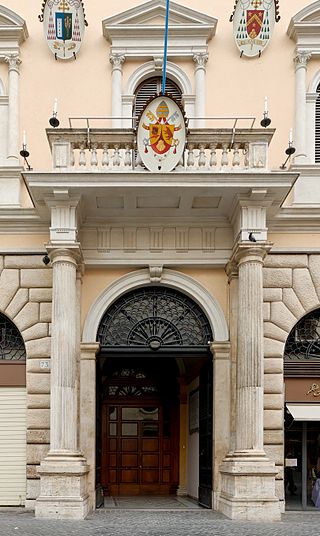Agents of Roman Congregations are persons whose business it is to look after the affairs of their patrons at the Roman Curia.
| |
| Part of a series on the |
| Roman Curia |
|---|
 |
| |
Agents of Roman Congregations are persons whose business it is to look after the affairs of their patrons at the Roman Curia.
The name is derived from the Latin Agens in Rebus, corresponding to the Greek Apocrisiarius (both have specific historical secular uses in the Roman/ Byzantine empires).
Such agents first appear for ecclesiastical matters not at the court of Rome, but at the imperial palace of Constantinople. Owing to the close connection between Church and State under the early Christian emperors and the absence of canons concerning many matters of mixed jurisdiction, the principal bishops found it necessary to maintain agents to look after their interests at the imperial court. Until the French Revolution, the prelates of France maintained similar agents at the royal court of St. Denis. [1]
By the 16th century, various curial congregations had the authority to decide petitions within the area of their own competence. The importance of mediators grew, [2] particularly on behalf of those who could not appear in person. [3]
While serving as Pope Urban VIII's unofficial representative in England, Carlo Rossetti not only managed to persuade some at the English court to banish Roman Catholic priests from England, rather than execute them, but also relayed requests for funds from Queen Henrietta Maria through his Barberini patrons. [4] As a cardinal, Alessandro Albani furthered the interests of the governments of Austria, Savoy and Britain against those of France and Spain.
The agents often acted as facilitators, helping to move requests or information through the curial bureaucracy. [5] In modern times the agents of the Roman Congregations were employed by bishops or private persons to transact their affairs in the pontifical courts. If it is a question of papal favors, such as dispensations or increased faculties, these agents prepare the proper paperwork, pay the filing fee and call repeatedly on the officials of the proper congregation until an answer is obtained. [6]
As rector of the Pontifical Irish College, Paul Cullen often acted as Roman agent for the Irish hierarchy. His successor, Tobias Kirby. was rector for forty-one years, during which time he acted as agent for Irish, Australian, Canadian, and American bishops. [7] Irish Benedictine Bernard Smith was Roman procurator for the English and American Benedictine congregations, and Roman agent for at least 22 American dioceses and several American religious communities. [8]
Under regulations promulgated by Pope Paul VI, it is forbidden for any dicastery official or subaltern "...to act in any way as agent, procurator, or advocate in one's own or in another dicastery." [9]
The Roman Curia comprises the administrative institutions of the Holy See and the central body through which the affairs of the Roman Catholic Church are conducted. The Roman Curia is the institution which the Roman Pontiff ordinarily makes use of in the exercise of his supreme pastoral office and universal mission in the world. It is at the service of the Pope, successor of Peter, and of the Bishops, successors of the Apostles, according to the modalities that are proper to the nature of each one, fulfilling their function with an evangelical spirit, working for the good and at the service of communion, unity and edification of the Universal Church and attending to the demands of the world in which the Church is called to fulfill its mission.

The Congregation for the Evangelization of Peoples was a congregation of the Roman Curia of the Catholic Church in Rome, responsible for missionary work and related activities. It is also known by its former title, the Sacred Congregation for the Propagation of the Faith, or simply the Propaganda Fide. On 5 June 2022, it was merged with the Pontifical Council for Promoting the New Evangelization into the Dicastery for Evangelization.

The Pontifical North American College (NAC) is a Roman Catholic educational institution in Rome, Italy, that prepares seminarians to become priests in the United States and elsewhere. The NAC also provides a residence for priests who are pursuing graduate work at other pontifical universities in Rome. The NAC also has a continuing education program for veteran priests.

The Congregation for Catholic Education (Institutes of Study) (Latin: Congregatio de Institutione Catholica (Studiorum Institutis)) was the pontifical congregation of the Roman Curia responsible for: universities, faculties, institutes and higher schools of study, either ecclesial or non-ecclesiastical dependent on ecclesial persons; and schools and educational institutes depending on ecclesiastical authorities.
In the Roman Curia of the Catholic Church, a congregation is a type of department of the Curia. They are second-highest-ranking departments, ranking below the two Secretariats, and above the pontifical councils, pontifical commissions, tribunals and offices.
The Prefecture of the Papal Household is the office in charge of the Papal Household, a section of the Roman Curia that comprises the Papal Chapel and the Papal Family.
Apostolic expeditors are Roman Curial officials who attend to the sending of Papal Bulls, Papal Briefs and Papal Rescripts emanating from the Apostolic Chancery, the Dataria, the Sacred Paenitentiaria and the Secretariate of Briefs.
The Congregation of Bishops and Regulars was a department of the Roman Curia that, beginning in the late 16th century, managed the diocesan bishops and those individuals, both male and female, and establishments associated with religious orders. It was also concerned with the relationship, at times contentious, between the two. The term regulars derives from the Latin regula meaning rule; it refers to those religious who follow a rule, as the Benedictines follow the Rule of St. Benedict. Its competence changed over time as the various dicasteries of the Roman Curia competed for jurisdiction, and by the 19th century included new institutions and their rules, the erection of monasteries and convents, granting transfers and leaves from such institutions, and their sale of property. It handled criminal cases as well. As late as 1903, this Congregation was described as "perhaps the most important congregation of the Roman Curia".
Pastor bonus is an apostolic constitution promulgated by Pope John Paul II on 28 June 1988. It instituted a number of reforms in the process of running the central government of the Catholic Church.

The Sacred Congregation of Ceremonies was a dicastery of the Roman Curia that was charged with the direction of all papal ceremonies as well as of the ceremonial of cardinals.
The Pontifical Commission for Latin America is a department of the Roman Curia that since 1958 has been charged with providing assistance to and examining matters pertaining to the Catholic Church in Latin America. The Commission operates under the auspices of the Dicastery for Bishops and for most of its history the prefect of that body has been president of the Commission.

The Bishops-Assistant at the Pontifical Throne were ecclesiastical titles in the Roman Catholic Church. It designated prelates belonging to the Papal Chapel, who stood near the throne of the Pope at solemn functions. They ranked immediately below the College of Cardinals and were also Counts of the Apostolic Palace. Assistants at the Pontifical Throne, unless specifically exempted, immediately enter the Papal nobility as Counts of Rome.

The Roman Colleges, also referred to as the Pontifical Colleges in Rome, are institutions established and maintained in Rome for the education of future ecclesiastics of the Catholic Church. Traditionally many were for students of a particular nationality. The colleges are halls of residence in which the students follow the usual seminary exercises of piety, study in private, and review the subjects treated in class. In some colleges there are special courses of instruction but the regular courses in philosophy and theology are given in a few large central institutions, such as Pontifical Urbaniana University, the Pontifical Gregorian University, the Pontifical Lateran University, and the Pontifical University of Saint Thomas Aquinas, Angelicum.
Salvatore "Rino" Fisichella is an Italian Catholic prelate with the rank of archbishop. He is the current pro-prefect for the New Evangelization section of the Dicastery for Evangelization. He was the president of the Pontifical Council for the Promotion of the New Evangelization from 2010-2022, and of the Pontifical Academy for Life from 2008-2010.
The Pontifical Academy of Martyrs is one of the ten Pontifical Academies established by the Holy See. It serves to advance the cult of saints and martyrs and the study of related early Christian history, including the catacombs. It operates with guidance and support from the Congregation for Divine Worship and the Discipline of the Sacraments and the Roman Curia.
The history of the Roman Curia, the administrative apparatus responsible for managing the affairs of the Holy See and the Catholic Church, can be traced to the 11th century when informal methods of administration began to take on a more organized structure and eventually a bureaucratic form. The Curia has undergone a series of renewals and reforms, including a major overhaul following the loss of the Papal States, which fundamentally altered the range and nature of the Curia's responsibilities, removing many of an entirely secular nature.
The Eastern Catholic canon law is the law of the 23 Catholic sui juris (autonomous) particular churches of the Eastern Catholic tradition. Eastern Catholic canon law includes both the common tradition among all Eastern Catholic Churches, now chiefly contained in the Code of Canons of the Eastern Churches, as well as the particular law proper to each individual sui juris particular Eastern Catholic Church. Oriental canon law is distinguished from Latin canon law, which developed along a separate line in the remnants of the Western Roman Empire, and is now chiefly codified in the 1983 Code of Canon Law.
Praedicate evangelium is an apostolic constitution reforming the Roman Curia and was published and promulgated on 19 March 2022 by Pope Francis; the document took effect on 5 June 2022.
The Dicastery for Culture and Education is an administrative unit of the Roman Curia. It began operations on 5 June 2022 as established by the apostolic constitution Praedicate evangelium promulgated on 19 March 2022. It was formed through the merger of two earlier bodies, the Pontifical Council for Culture and the Congregation for Catholic Education.
The Dicastery for Evangelization is a department (dicastery) of the Roman Curia. It was created on 5 June 2022 through the merger of the Pontifical Council for Promoting the New Evangelization and the Congregation for the Evangelization of Peoples, by the apostolic constitution Praedicate evangelium.